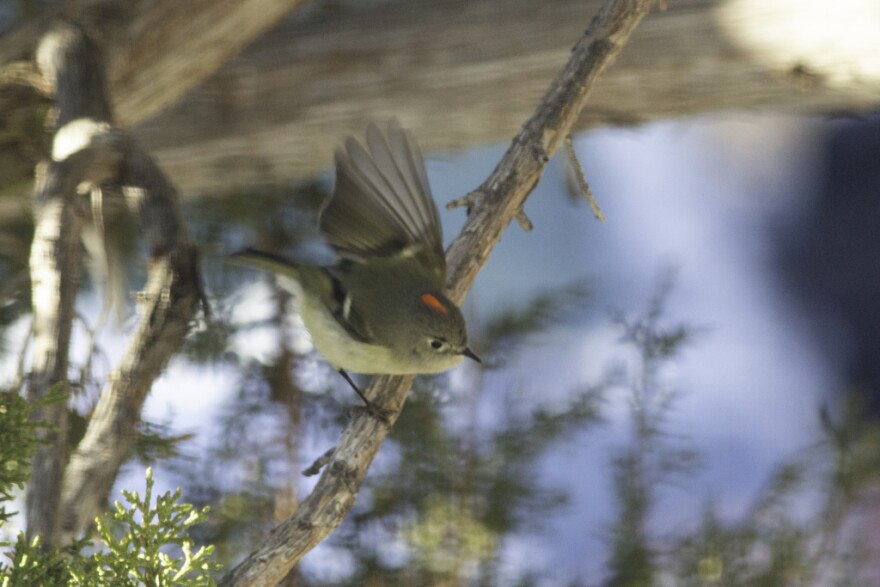It's time for our weekly nature check-in, and we start this week on a large-scale issue! John reports that this chilly spring may be part of a longer-term pattern due to climate change. One of the effects of the changing climate is that more cold air is being pushed out of Canada into the northern United States this time of year, generating a chillier, more delayed spring. How's that for a bummer of a beginning?
Luckily, things brighten up quickly when John spots a ruby-crowned kinglet outside his window. Pretty awesome! (Sidenote: I saw my second-ever ruby-crowned kinglet this week! I'm sure I've had the opportunity to see them before, but this was the first time I'd ever seen one with the time, energy, and ability to identify it to species. It helped that it was flaunting its little red cap!)
On Monday the 25th, John saw the first northern flicker of the season; he estimates it arrived about 13 days later than average. However, his computer refused to let him look at his data, so he is running on memory for the broadcast! He also saw an American kestrel, a pine warbler, and a few fox sparrows migrating northward. In the past week, the hundred or so redpolls that were active at his feeder all left, and most of the 50-60 resident juncos followed suit.
The loons remain active and mobile in the area! They are assembling by necessity in the open water of the Mississippi River, but doing daily fly-bys of the lakes to determine if the ice has melted. John's nearby lake, Crooked Lake, is still iced over. On average, it is clear by April 14th, with extremes of March 31st in 2012 and May 10th in 2013. John predicts that ice-out will occur between May 5th and the 10th: we'll have to wait and see!
The bloodroot (named for its sticky red sap) has already bloomed at John's sister-in-law's house. The radiant heat from the house likely helped it along! John's bloodroot is only out of the soil by about an inch and is easily covered by the leaf litter. You can identify it at this stage by looking for pinkish-white shoots, but you'll probably have to kick aside the leaves to find it! Bloodroot typically blooms around April 23rd, but has bloomed as early as April 2nd (2012) and as late as May 11th (2002).
In the 'mythical typical' year, aspen leaves would be emerging on April 29th, the end of this week! Since we are doomed to a lifetime of variations from the norm, that's sure not happening on time this year- the male flowers aren't fully distended yet, so they haven't even completed the first step. The aspens follow a pattern of reproductive stages called phenophases: first, the male flowers develop and distend on the male trees. The female trees put out their flowers later, once the male flowers are about three centimeters long and ready to release pollen. Only after flowering and pollination do the leaves emerge! With that in mind, John estimates we won't see any aspen leaves until the end of the first week of May.
John looked "very assiduously" for flowers on the beaked hazel and had no luck. They emerge, on average, on April 10th: the range is from March 19th (2012) to April 29th (2013). So, we're just three days away from a new record. It seems unlikely that the weather will encourage development: temperatures will be in the teens and twenties overnight through the next week. We'll excitedly await our update next Tuesday!
In miscellaneous plant news, Juneberry buds have not opened yet, but you can see little white hairs on the edges of the bud scales. The red elderberries have broken bud three times this spring, and each time the frost has killed the developing leaves and flowers. Similarly, the red maple burst bud during the last week, and John suspects the male flowers were all killed by the overnight frosts. So, there likely won't be many silver maple seeds this year. The Canada fly honeysuckle, that maverick of a plant, has bucked all the trends and has already broken bud! John states that it's remarkably early, given all the cold weather, but hey- nature is weird!
As you drive around, take an extra look at the willows. Willow trees, which have been displaying vibrant orange and yellow colors since the end of winter, are now distinguishable by sex. Willows are dioecious, meaning they have distinct male and female plants. Male trees are pollen-covered, and female trees are covered in flowers! The shrub willows tend to have green shoots and red or burgundy tips. John instructs us to enjoy the beautiful colors before they get concealed by the green leaves!
John leaves us with this: "It's been a long, long spring: not the longest ever, but getting there! I'll keep track of it for you. Hang in there: spring is coming!" Thanks, John- it's good to have my cabin fever validated!










